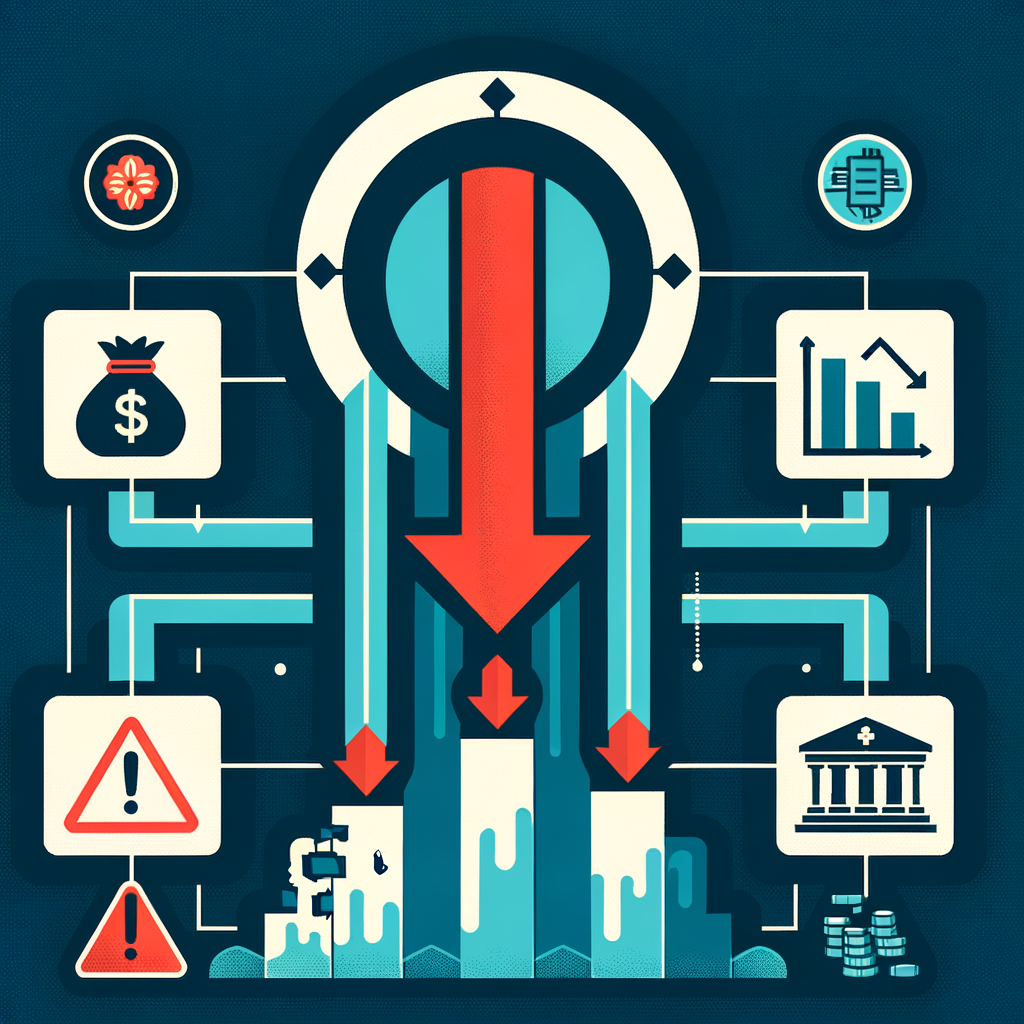How Can Poor Cash Flow Management Lead to Business Failure? A Guide for Indian Entrepreneurs
It’s a stark reality for Indian entrepreneurs: a significant number of small businesses shut down within their first five years. While many assume this is due to a lack of customers or profitability, the real culprit is often silent and far more dangerous—a lack of cash. The number one reason cash flow management leading to business failure is so tragically common is that business owners often mistake profit on their accounting books for actual cash in the bank. This fundamental misunderstanding can unravel even the most promising ventures. Your business doesn’t run on profit; it runs on cash. Cash is the oxygen that fuels your daily operations, pays your team, and keeps the lights on. This guide will dissect the critical warning signs of a cash flow crisis, explain the devastating domino effect it can trigger, and provide you with actionable strategies to take firm control of your company’s financial health.
Understanding Cash Flow vs. Profit: The Foundation of Financial Health
For any new entrepreneur, grasping the difference between cash flow and profit is the single most important financial lesson. Failing to understand this distinction is like trying to navigate a ship without a compass; you might seem to be moving forward, but you could be heading straight for the rocks.
The Profit Illusion: Why Sales on Credit Aren’t Cash in the Bank
Profit is a calculation, while cash is a reality. Profit is what’s left after you subtract your business expenses from your revenue. However, much of that revenue might not have been collected yet. Let’s consider a simple, relatable example. Imagine you run a graphic design agency in Mumbai. You complete a large project for a client and send them an invoice for ₹50,000. On your profit and loss statement, you’ve officially earned ₹50,000 in revenue, which looks fantastic. However, your client has a 60-day payment term. This means for the next two months, your business is “profitable” on paper but has zero cash from that sale to pay your office rent, employee salaries, or your software subscriptions. This gap between recording a sale and receiving the money is where businesses falter. This highlights the importance of cash flow management in India, especially for service-based businesses or B2B companies that regularly deal with long payment cycles.
What is a Positive Cash Flow?
Simply put, a positive cash flow means that over a specific period (like a month or a quarter), your business has more money coming in than going out. This incoming cash is not just from sales but can also include loan receipts or owner investments. Outgoing cash covers all your expenses, such as supplier payments, rent, utility bills, salaries, marketing costs, and crucial statutory dues like GST and TDS. Having a positive cash flow is the sign of a healthy, sustainable business. It means you have the liquid funds necessary to meet your short-term obligations without stress, handle unexpected emergencies, and invest in opportunities for growth. Without it, even a business with high-profit margins can find itself unable to operate.
The Red Flags: 7 Early Warning Signs of Cash Flow Problems
Cash flow issues rarely appear overnight. They begin as small symptoms that, if ignored, can escalate into a full-blown financial crisis. Learning to spot these early warning signs is crucial for survival. This section details the poor cash flow effects on business that you must watch for.
1. You’re Struggling to Pay Suppliers and Bills on Time
This is the most direct and unmistakable sign of a cash flow problem. When you start “juggling” bills—deciding whether to pay the rent or a key supplier this week—you are already in a danger zone, falling into one of the Top 10 Financial Mistakes Small Businesses Make. Consistently paying your suppliers late can severely damage your business relationships. They may stop offering you favorable credit terms and start demanding cash on delivery, which will only worsen your cash crunch and strain your operations.
2. Your Accounts Receivable is Growing, But Your Bank Balance Isn’t
Accounts Receivable (AR) is the total amount of money your customers owe you for goods or services they have already received. While a growing AR indicates you are making sales, it’s a major red flag if your bank balance isn’t growing alongside it. A large and aging AR balance means your collection process is inefficient. You are effectively providing your customers with a free loan, while your own business starves for cash.
3. Constant Reliance on Overdrafts or Short-Term Credit
There is a significant difference between using a business loan for a strategic purpose, like buying new machinery to increase production, and using your bank’s overdraft facility to cover monthly salaries. If you find yourself constantly leaning on short-term, high-interest credit just to meet basic operational expenses, it’s a clear signal that your core business operations are not generating enough cash to sustain themselves.
4. You Are Delaying GST and TDS Payments
In the Indian business ecosystem, this is a five-alarm fire. Delaying or defaulting on statutory payments like Goods and Services Tax (GST) and Tax Deducted at Source (TDS) is not a viable cost-saving measure; it’s a path to disaster. The government imposes heavy penalties, interest on the due amount, and can initiate legal proceedings. This is a severe impact of cash flow problems on Indian businesses, as it not only creates a massive financial liability but also puts your business’s legal standing at risk.
5. You Have to Postpone or Cancel Necessary Purchases
Is your primary delivery vehicle constantly breaking down, but you can’t afford to replace it? Do you need to restock critical inventory to fulfill new orders but lack the funds to do so? When cash flow problems force you to postpone or cancel essential purchases, you are crippling your business’s ability to operate effectively and serve your customers, creating a vicious cycle of decline.
6. Employee Morale is Dropping Due to Salary Delays
Your employees are your most valuable asset. If you are consistently delaying salary payments, you can expect a sharp decline in morale, productivity, and loyalty. Your best and most skilled employees, who have other options, will be the first to leave. This leads to high employee turnover, increased recruitment costs, and a loss of institutional knowledge, all of which further damage your business.
7. You Can’t Afford to Invest in Growth
A healthy business is a growing business. Growth requires investment—in marketing campaigns to attract new customers, in technology to improve efficiency, or in hiring new talent to expand your capabilities. If your business is in a constant state of cash-strapped survival, you will miss out on every single one of these opportunities, leaving you stagnant while your competitors move ahead.
The Domino Effect: How Poor Cash Flow Management Leads to Business Failure
A single cash flow issue rarely stays isolated. It triggers a predictable chain reaction, a domino effect where each problem exacerbates the next, creating a downward spiral that is difficult to escape. This is precisely how cash flow management leading to business failure becomes an almost inevitable process once the first domino falls.
Step 1: Damaged Reputation and Loss of Credit
The first domino to fall is your reputation. When you start paying suppliers late, word gets around. Your vendors, who once offered you 30 or 60-day credit terms, will lose trust. They will shorten your payment windows or, worse, shift you to a “Cash on Delivery” (COD) or “Advance Payment” model. This immediately tightens your cash flow even further. Now, you need cash upfront to procure the very materials you need to generate future revenue, digging the hole deeper. Your business credit score will also take a hit, making it harder and more expensive to secure loans in the future.
Step 2: Mounting Legal and Financial Penalties
The next domino is non-compliance. In a desperate attempt to conserve cash, you might delay statutory payments. This is where the impact of cash flow problems on Indian businesses becomes particularly severe due to a strict compliance framework.
- GST Penalties: If you file your GST returns late, you are liable for a late fee. To ensure timely compliance, it’s essential to know How to File GST Returns Online: A Step-by-Step Guide of the GST Filing Process & Procedure. More critically, if you delay paying the GST amount you’ve collected, you will be charged interest, which is currently 18% per annum. This interest accrues daily, turning a small tax liability into a substantial debt. You can find the latest penalty structures on the official GST Portal.
- TDS Penalties: The rules for Tax Deducted at Source (TDS) are even more stringent. There is interest for late deduction (1% per month) and a higher interest for late deposit of the deducted tax (1.5% per month). These penalties are non-negotiable and can quickly accumulate, attracting scrutiny and notices from the Income Tax Department.
Step 3: Loss of Key Talent and Operational Breakdown
As financial stress mounts, it inevitably affects your team. When salaries are delayed, your most talented and experienced employees will start looking for more stable opportunities. Their departure creates a massive operational gap. Service quality drops, production slows down, and customer satisfaction plummets. This decline in operational efficiency leads to fewer sales and more customer complaints, further reducing your incoming cash flow and accelerating the downward spiral.
Step 4: The Final Inability to Operate
This is the final, tragic domino. The business reaches a point of total paralysis. With a damaged reputation, no credit from suppliers, mounting legal penalties, a demoralized or departed workforce, and dwindling sales, you can no longer afford the absolute essentials. You cannot pay the rent for your office or factory, the electricity bill, or the salaries of your remaining core staff. At this stage, the business has no choice but to cease operations completely. This is the ultimate consequence of cash flow problems leading to failure—a complete and often irreversible shutdown.
Proactive Solutions: A Practical Guide to Cash Flow Management in India
The good news is that this grim outcome is preventable. You don’t have to be a finance wizard to protect your business. Understanding cash flow management for businesses is a skill that can be learned and implemented with discipline and the right tools. It’s about being proactive, not reactive, which is a core theme in our A Guide to Budgeting and Financial Planning for Startups.
1. Create and Maintain a Cash Flow Projection
You cannot manage what you do not measure. A cash flow projection, or forecast, is your most powerful tool. It’s an estimate of the money you expect to move in and out of your business over a given period. We recommend creating one weekly, or at the very least, monthly. A simple forecast can be structured like this:
| Component | Description | Example |
|---|---|---|
| Opening Cash Balance | The cash you have at the start of the period. | ₹1,00,000 |
| (+) Cash Inflows | All expected cash receipts (Sales, loan funds, etc.). | ₹2,50,000 |
| (-) Cash Outflows | All expected cash payments (Rent, salaries, GST, purchases, etc.). | ₹2,00,000 |
| (=) Closing Cash Balance | The cash you expect to have at the end of the period. | ₹1,50,000 |
This simple exercise will help you anticipate future cash shortfalls and give you time to take corrective action.
2. Aggressively Manage Your Accounts Receivable
Don’t let your business become an interest-free bank for your customers. You need a systematic and aggressive approach to collecting what you are owed.
- Invoice Immediately: Send invoices the moment a job is completed or goods are delivered.
- Offer Early Payment Discounts: A small discount, like 2% off for payment within 10 days, can incentivize customers to pay you faster.
- Enforce Clear Payment Terms: Your terms (e.g., “Due in 30 days”) should be clearly stated on every invoice.
- Follow Up Systematically: Have a process for following up. Send a polite reminder a few days before the due date, another on the due date, and then begin regular follow-ups for overdue invoices.
3. Strategically Manage Your Accounts Payable
Just as you manage your inflows, you must strategically manage your outflows (Accounts Payable). This doesn’t mean not paying your bills; it means paying them smartly.
- Negotiate Better Terms: When possible, negotiate longer payment terms with your suppliers to better align with your own cash collection cycle.
- Prioritize Payments: Always pay high-priority obligations first. This order should be: 1) Statutory dues (GST, TDS, PF), 2) Payroll, 3) Critical suppliers who are essential for your operations, and 4) Other non-essential bills.
- Don’t Pay Too Early: Unless you are getting a discount for early payment, hold onto your cash until the bill’s due date. This maximizes the cash available to you for daily operations.
4. Build a Cash Reserve (Business Emergency Fund)
Every business will face unexpected expenses or a sudden drop in sales. A cash reserve is your safety net. Aim to set aside 3 to 6 months’ worth of essential operating expenses (rent, salaries, utilities) in a separate, easily accessible savings account. This fund will allow you to navigate tough times without having to resort to high-interest debt or making desperate decisions.
5. Plan for Your Tax and Compliance Obligations
Taxes are not a surprise; they are a predictable business expense. You must plan for them. GST, Advance Tax, and TDS payments should be forecasted in your cash flow projection. A highly effective tip is to open a separate bank sub-account for your tax liabilities. Every time you receive a payment from a customer, immediately transfer the GST portion of that payment into this tax account. This simple discipline ensures the money is there when your GST payment is due and prevents you from accidentally spending it on operational expenses. For income tax, check the official Income Tax Department website for the due dates for Advance Tax installments and plan accordingly.
Conclusion
The journey of an entrepreneur is challenging enough without being blindsided by a preventable cash flow crisis. Remember the fundamental lesson: profit is an opinion, but cash is a fact. By understanding the critical difference between the two, recognizing the early warning signs like late payments and compliance delays, and implementing proactive strategies, you can build a resilient and financially healthy business. Effective financial planning isn’t optional; it’s the bedrock of sustainable success. Proactive oversight is the only way to prevent cash flow management leading to business failure.
Don’t wait for a crisis to put your finances in order. Take control of your financial future today. If you’re overwhelmed by accounting, tax compliance, or need help creating a robust cash flow strategy, contact the experts at TaxRobo for a consultation. We simplify finance so you can focus on what you do best—growing your business.
Frequently Asked Questions (FAQs)
1. What is the very first step I should take to improve my business’s cash flow?
Answer: The very first step is to gain clarity. Start by creating a simple cash flow statement for the last 3 months to understand exactly where your money has been going. Track every inflow and outflow. Then, use that historical data to build a forward-looking cash flow projection for the next 3 months. This exercise alone will give you a powerful picture of your past, present, and future financial position, allowing you to spot problems before they occur.
2. Can a company be profitable but still go bankrupt?
Answer: Absolutely. This is a classic business scenario and a perfect example of why cash flow is king. A company can be highly profitable on paper, with lots of sales recorded in its accounting books. However, if it fails to collect cash from its customers in time to pay its own immediate expenses like supplier bills, employee salaries, and taxes, it will face a liquidity crisis. This is a classic case of cash flow problems leading to failure, even in a profitable business.
3. How does GST impact cash flow management in India?
Answer: GST has a very direct and significant impact on cash flow management in India. Under the GST regime, your liability to pay the tax to the government arises when you issue an invoice (on an accrual basis), not when you actually receive the payment from your customer. For example, if you issue an invoice in April with a 60-day payment term, you are still required to pay the GST on that sale to the government by the 20th of May. If your customer hasn’t paid you by then, you must pay the GST out of your own working capital, which can create a serious cash crunch.
4. How often should a small business owner review their cash flow?
Answer: For a small business where finances can be volatile, reviewing your cash flow position on a weekly basis is ideal. A weekly review allows you to react quickly to any unexpected changes, chase overdue payments promptly, and manage upcoming expenses effectively. This frequent check-in helps you spot potential shortfalls early and take corrective action before they become major, business-threatening problems. A monthly review should be considered the absolute minimum.



